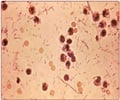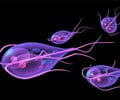Indian J Med Microbiol
Detection and molecular typing of campylobacter isolates from human and animal faeces in coastal belt of Odisha, India.
Mohakud NK, Patra SD, Kumar S, Sahu PS, Misra N, Shrivastava AK
Campylobacter-mediated diarrhoea is one of the major causes of gastroenteritis globally. A majority of the Campylobacter spp. that cause disease in hu ...
Read More
Source: PubMed
Epidemiol. Infect.
Campylobacter outbreak associated with raw drinking milk, North West England, 2016.
Kenyon J, Inns T, Aird H, Swift C, Astbury J, Forester E, Decraene V
In December 2016, Public Health England investigated an outbreak of campylobacteriosis in North West England, with 69 cases in total. Epidemiological, ...
Read More
Source: PubMed
PLoS ONE
Increasing prevalence of a fluoroquinolone resistance mutation amongst Campylobacter jejuni isolates from four human infectious intestinal disease studies in the United Kingdom.
Haldenby S, Bronowski C, Nelson C, Kenny J, Martinez-Rodriguez C, Chaudhuri R, Williams NJ, Forbes K, Strachan NJ, Pulman J, Winstanley IN, Corless CE, Humphrey TJ, Bolton FJ, O'Brien SJ, Hall N, Hertz-Fowler C, Winstanley C
Campylobacter jejuni is the most common bacterial cause of human infectious intestinal disease. ...
Read More
Source: PubMed
Food Saf (Tokyo)
Current Status of Campylobacter Food Poisoning in Japan.
Vetchapitak T, Misawa N
According to the annual food poisoning statistics compiled by the Ministry of Health, Labour and Welfare (MHLW) in Japan, Campylobacter replaced Salmo ...
Read More
Source: PubMed
Appl. Environ. Microbiol. 2020 Jan 24
Role of caecal microbiota in the differential resistance of inbred chicken lines to colonization by Campylobacter jejuni.
Chintoan-Uta C, Wisedchanwet T, Glendinning L, Bremner A, Psifidi A, Vervelde L, Watson K, Watson M, Stevens MP
Campylobacter is the leading foodborne bacterial diarrhoeal illness in many countries, with up to 80 % of human cases attributed to the avian reservoi ...
Read More
Source: PubMed














